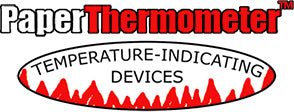Use of Thermolabel® Test Strips in Commercial Dishwashers
View/Download Printable PDF Version

Paper Thermometer’s most popular test strip for use in verifying dishwasher sanitation is the 1-Temp Thermolabel 160°F (71°C). Various other 1-Temp Thermolabels are also used when low temperature chemical sanitation warewashers are in use. Additionally, Paper Thermometer 3-Temp Thermolabel 150°F 160°F 170°F (65.6°C 71°C 77°C) and 3-Temp Thermolabel 160°F 170°F 180°F (71°C 77°C 82°C) dishwasher labels are often used by individuals who want a broader range of temperatures in order to aid in adjusting a warewasher. For verifying final rinse water temperature, the Dishwasher Rinse Temp Thermolabel 180°F/82°C is available. Thermolabels can be used with all styles of warewashers including door dishwashers, conveyor dishwashers, undercounter dishwashers and flight dishwashers.

We often receive questions from sanitarians, health departments, and restaurant owners about how Paper Thermometer test strips are used to test dishwasher sanitation. One of the most common questions that is asked is why a 160°F (71°C) temp label did not change to black when the dishwasher rinse water was set to 180°F (82°C). What we would like to remind people in these situations is that the test strip, which is attached to your plate, glass or other dishware, tests the temperature of the surface it is on. The temperature of a particular surface is not necessarily equal to the ambient temperature. The rinse water temperature needs to increase the surface temperature of the dishware to 160°F (71°C) and hold it at or above that temperature for at least a few seconds in order for the dishwasher label to indicate that 160°F (71°C) has been reached. One brief spray of 180°F (82°C) rinse water does not guarantee that everything being hit is instantly brought to 180°F (82°C) or even to 160°F (71°C). It takes time for the temperature to rise to this level. The previous temperature of the dishware and its composition (material, thickness, etc) affects how rapidly this temperature change occurs. When the temperature sensitive element in a test strip changes to black at its edges only, this is an indication that the surface reached 160°F (71°C) but for too short of a period for the label to react completely.
During the first cycle or two after being turned on for the day, the dishwasher itself will be absorbing some of the heat of the wash and rinse waters. This loss of heat will be enough to prevent the dishes from reaching the required sanitation temperature. It is important not to test dish sanitation temperature during the first run of the dishwasher. Allow the dishwasher to come up to temperature and then run a couple of empty cycles before proceeding with testing the dish surface temperature using a 160°F (71°C) temperature label.
Another common topic that we receive questions about is the proper placement of Thermolabel temperature indicators. The placement of the temperature label is definitely important. The label must be affixed to the surface that is being sanitized. Placing a label on the dishwasher rack would only serve to verify that the rack was sanitized, clearly not the purpose of the test. Affix the Paper Thermometer dishwasher label to a clean dish or glass to verify that your dishware is being sanitized. Press firmly and ensure that no air is trapped beneath the label. Make sure that the surface is clean; food debris beneath the temperature label can alter its effectiveness. Do not place the label loose in the dishwasher because the result will not accurately indicate whether or not the dishware has been sanitized. The temperature label must be affixed to a surface.

Sometimes we will get a call from a restaurant owner stating that a sanitarian has told him/her that they need to use 180°F (82°C) test strips in their warewasher. This is likely incorrect; we have never encountered a situation where someone actually needs to verify that their dishware has reached 180°F (82°C). When someone requests 180°F (82°C) Thermolabel temperature labels it almost always ends up being a miscommunication between the restaurant owner and the sanitarian. The U.S. Food and Drug Administration Food Code specifically states that “achieving a utensil surface temperature of 71°C (160°F) as measured by an irreversible registering temperature indicator” is required. Other Food Code temperature regulations can apply, for instance in dishwashers that operate with chemical sanitation but the general required temperature is 160°F (71°C). Chemical sanitation typically requires a Thermolabel test strip of a lower temperature, such as 110°F (43.3°C) or 140°F (60°C).
Further information can be found on the FDA’s website, particularly within Section 4-703.11 (B) of the Food Code.
Have questions on using Thermolabel temp strips in your dishwasher? Please contact us, we are always happy to offer assistance.
